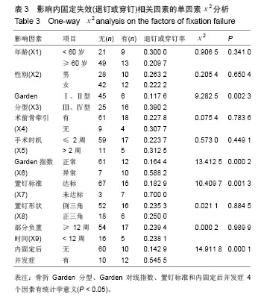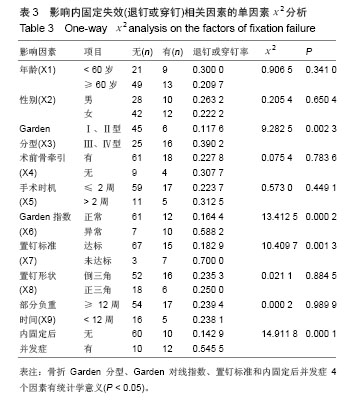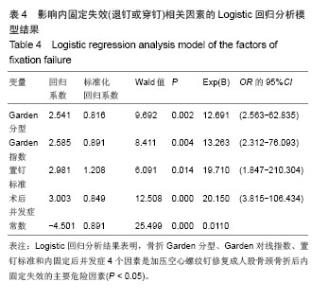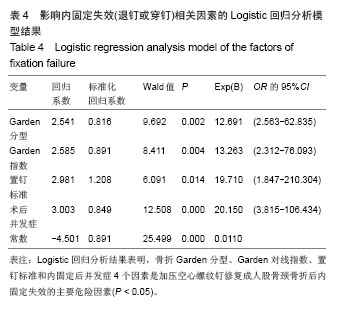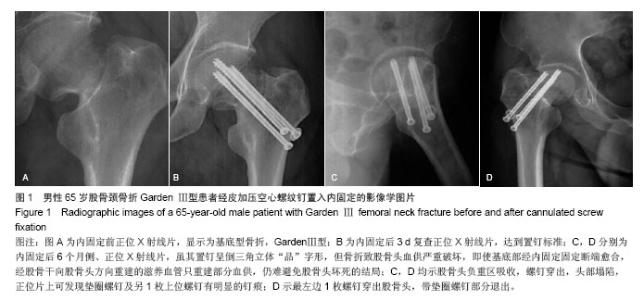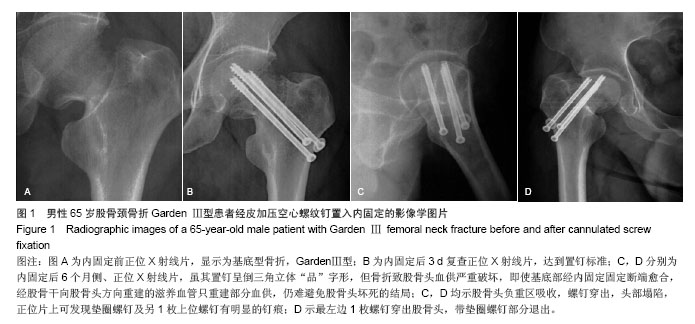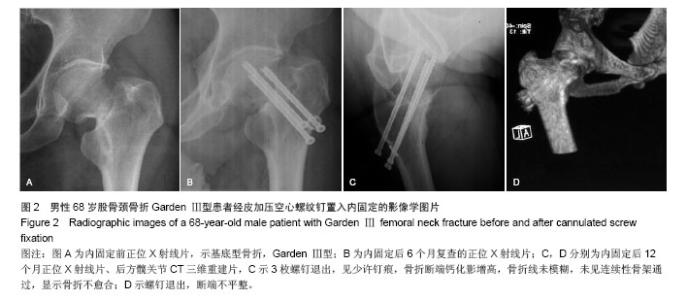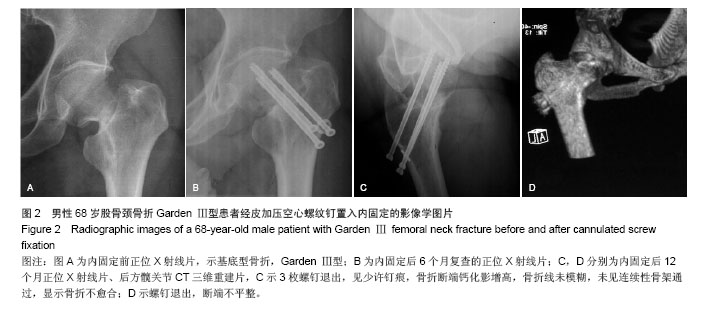Chinese Journal of Tissue Engineering Research ›› 2014, Vol. 18 ›› Issue (44): 7138-7145.doi: 10.3969/j.issn.2095-4344.2014.44.016
Previous Articles Next Articles
Analysis of internal fixation failure after cannulated screws for adult femoral neck fracture
Zhao Qi, Liu Shi-qing, Ming Jiang-hua, Zhou Yan, Liao Qi, Zhang Chun, Yang Yue
- Department of Orthopaedic Surgery, Renmin Hospital of Wuhan University, Wuhan 430060, Hubei Province, China
-
Online:2014-10-22Published:2014-10-22 -
Contact:Liu Shi-qing, Professor, Chief physician, Doctoral supervisor, Department of Orthopaedic Surgery, Renmin Hospital of Wuhan University, Wuhan 430060, Hubei Province, China -
About author:Zhao Qi, Studying for master’s degree, Department of Orthopaedic Surgery, Renmin Hospital of Wuhan University, Wuhan 430060, Hubei Province, China
CLC Number:
Cite this article
Zhao Qi, Liu Shi-qing, Ming Jiang-hua, Zhou Yan, Liao Qi, Zhang Chun, Yang Yue. Analysis of internal fixation failure after cannulated screws for adult femoral neck fracture[J]. Chinese Journal of Tissue Engineering Research, 2014, 18(44): 7138-7145.
share this article
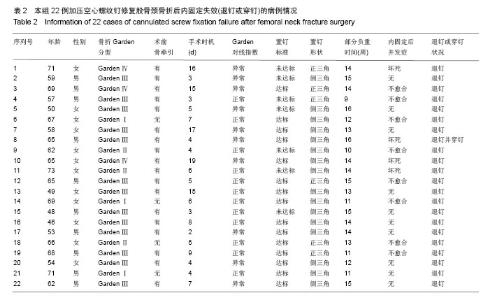
2.1 参与者数量分析 按意向性处理,共纳入92例患者,将患者年龄、性别、骨折Garden分型、术前骨牵引、手术时机、Garden对线指数、置钉标准、置钉形状、部分负重时间、内固定后并发症等相关信息进行统计,全部进入结果分析,无脱落。 2.2 髋关节功能 92例行加压空心螺纹钉内固定治疗的股骨颈骨折患者获18-72个月随访,末次随访时髋关节按Harris评定标准评价:优28例,良25例,可17例,差22例,优良率为58%。 2.3 影像学结果 根据骨折愈合及骨坏死的相关标准,对影像学资料和临床体征进行分析。 结果显示,本组内固定后骨折不愈合9例,其中Garden Ⅰ型2例,Ⅱ型2例,Ⅲ型3例,Ⅳ型2例;股骨头缺血性坏死13例,其中Garden Ⅰ型3例,Ⅱ型4例,Ⅲ型3例,Ⅳ型3例。内固定失效(退钉或穿钉)共22例,具体信息见表2。 "
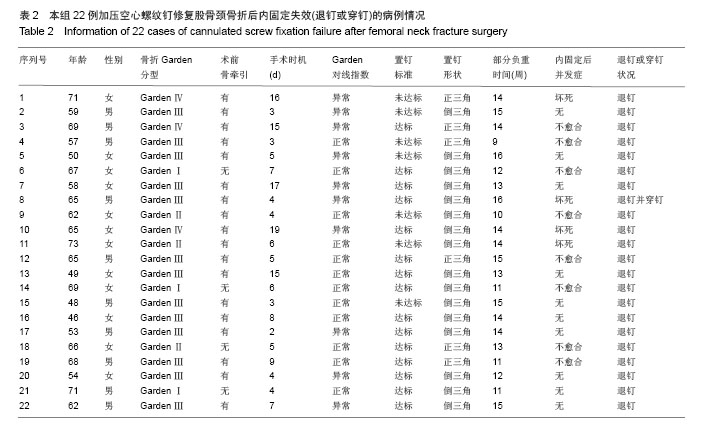
| [1]Zielinski SM, Keijsers NL, Praet SF, et al. Functional outcome after successful internal fixation versus salvage arthroplasty of patients with a femoral neck fracture. J Orthop Trauma. 2014.
[2]Andruszkow H, Scharff B, Zapf A, et al. [Influence of comorbidities and delay in surgical treatment on mortality following femoral neck fracture]. Z Orthop Unfall.2013;151(4): 338-342.
[3]O'Toole RV, Dancy L, Dietz AR, et al. Diagnosis of femoral neck fracture associated with femoral shaft fracture: blinded comparison of computed tomography and plain radiography. J Orthop Trauma. 2013;27(6): 325-330.
[4]Cao L, Wang B, Li M, et al. Closed reduction and internal fixation versus total hip arthroplasty for displaced femoral neck fracture. Chin J Traumatol. 2014;17(2): 63-68.
[5]Pauyo T, Drager J, Albers A, et al. Management of femoral neck fractures in the young patient: A critical analysis review. World J Orthop. 2014;5(3): 204-217.
[6]Zhou GQ, Pang ZH, Chen QQ, et al. Reconstruction of the biomechanical transfer path of femoral head necrosis: a subject-specific finite element investigation. Comput Biol Med. 2014;52:96-101.
[7]Unger AC, Dirksen B, Renken FG, et al. Treatment of femoral neck fracture with a minimal invasive surgical approach for hemiarthroplasty - clinical and radiological results in 180 geriatric patients. Open Orthop J. 2014;8:225-231.
[8]Mei J. A brief history of internal fixation of femoral neck fracture. Zhonghua Yi Shi Za Zhi. 2014;44(2): 101-105.
[9]Zhao W, Liu L, Zhang H, et al. Effect of dynamic hip screw on the treatment of femoral neck fracture in the elderly. Chin J Traumatol. 2014;17(2): 69-72.
[10]Wani IH, Sharma S, Latoo I, et al. Primary total hip arthroplasty versus internal fixation in displaced fracture of femoral neck in sexa- and septuagenarians. J Orthop Traumatol. 2014;15(3): 209-214.
[11]Johansson T. Internal fixation compared with total hip replacement for displaced femoral neck fractures: a minimum fifteen-year follow-up study of a previously reported randomized trial. J Bone Joint Surg Am. 2014; 96(6): e46.
[12]Fisher MA, Matthei JD, Obirieze A, et al. Open reduction internal fixation versus hemiarthroplasty versus total hip arthroplasty in the elderly: a review of the National Surgical Quality Improvement Program database. J Surg Res. 2013; 181(2): 193-198.
[13]Laurer HL, Wutzler S, Possner S, et al. Outcome after operative treatment of Vancouver type B1 and C periprosthetic femoral fractures: open reduction and internal fixation versus revision arthroplasty. Arch Orthop Trauma Surg. 2011;131(7): 983-989.
[14]Seitz WH Jr, Berardis JM, Giannaris T, et al. Perforation of the rectum by a Smith-Petersen nail. J Trauma.1982;22(4): 339-340.
[15]Ji SC. [Application of self-made wire guide apparatus for Smith-Petersen nailing (author's transl)]. Zhonghua Wai Ke Za Zhi. 1981;19(4): 239-241.
[16]Burton KG. Fractures of the femoral neck: primary treatment with a smith-petersen nail and primary autogenous-bone graft. A long-term follow-up study. J Bone Joint Surg Am. 1964;46: 1659-1675.
[17]Svendsen RN, Hermansson S, Noer HH. Osteosynthesis of medial femoral neck fractures with 2 Hansson nails. Ugeskr Laeger. 1991;153(12): 847-849.
[18]Toriumi H, Miyasaka T, Uchiyama S, et al. Utilization of a partially threaded Kirschner wire in the treatment of femoral neck fractures. J Orthop Trauma. 1998;12(5): 320-323.
[19]He W, Zhang W. The Curative Effect Comparison Between Prolonged Third Generation of Gamma Nail and Prolonged Dynamic Hip Screw Internal Fixation in Treating Femoral Intertrochanteric Fracture and the Effect on Infection. Cell Biochem Biophys. 2014.
[20]Schwartsmann CR, Jacobus LS, Spinellilde F, et al. Dynamic hip screw for the treatment of femoral neck fractures: a prospective study with 96 patients. ISRN Orthop. 2014;2014: 257871.
[21]Friedl W, Ruf W. Experimental studies of the effectiveness of the sliding principle in dynamic hip screw osteosynthesis and its value in managing unstable pertrochanteric femoral fractures. Chirurg. 1987;58(2): 106-112.
[22]Claes L, Becker C, Simnacher M, et al. [Improvement in the primary stability of the dynamic hip screw osteosynthesis in unstable, pertrochanteric femoral fractures of osteoporotic bones by a new glass ionomer cement]. Unfallchirurg. 1995; 98(3): 118-123.
[23]Griffin XL, Parsons N, Achten J, et al. the Targon femoral neck hip screw versus cannulated screws for internal fixation of intracapsular fractures of the hip: a randomised controlled trial. Bone Joint J. 2014; 96-B(5): 652-657.
[24]Kaplan T, Akesen B, Demirag B, et al. Comparative results of percutaneous cannulated screws, dynamic compression type plate and screw for the treatment of femoral neck fractures. Ulus Travma Acil Cerrahi Derg. 2012;18(1): 65-70.
[25]Tian W, Cui Z, Kan S. [Comparison of cannulated screws fixation with different reduction methods at different time points for displaced femoral neck fractures in terms of fracture healing]. Zhongguo Xiu Fu Chong Jian Wai Ke Za Zhi. 2009; 23(4): 440-443.
[26]Robinson CM, Adams CI, Craig M, et al. Implant-related fractures of the femur following hip fracture surgery. J Bone Joint Surg Am. 2002;84-A(7): 1116-1122.
[27]Kelly DW, Kelly BD. A novel diagnostic sign of hip fracture mechanism in ground level falls: two case reports and review of the literature. J Med Case Rep. 2012;6:136.
[28]Vecsei V, Manninger J. [Diagnostic measures and therapeutic procedure in dislocated medial femoral neck fracture with the aim of saving the head before the age of prosthesis]. Z Unfallchir Versicherungsmed Berufskr. 1983;76(3):151-154.
[29]Aggarwal A, Singh M, Aggarwal AN, et al. Assessment of interobserver variation in Garden classification and management of fresh intracapsular femoral neck fracture in adults. Chin J Traumatol. 2014;17(2): 99-102.
[30]Frandsen PA, Andersen E, Madsen F, et al. Garden's classification of femoral neck fractures. An assessment of inter-observer variation. J Bone Joint Surg Br.1988;70(4): 588-590.
[31]Mao YJ, Wei J, Zhou L, et al. [Related factor analysis of avascular necrosis of the femoral head after internal fixation with cannulated screws in femoral neck fractures]. Zhonghua Yi Xue Za Zhi. 2005;85(46): 3256-3259.
[32]Eliasson P, Hansson LI, Karrholm J. Displacement in femoral neck fractures. A numerical analysis of 200 fractures. Acta Orthop Scand. 1988;59(4): 361-364.
[33]Holmberg S, Thorngren KG. Statistical analysis of femoral neck fractures based on 3053 cases. Clin Orthop Relat Res. 1987; 218: 32-41.
[34]Yu YX, Ma JZ, Zhu LB, et al. Failure of internal fixation on displaced femoral neck fractures in adults under fifty-five years old. Zhongguo Gu Shang. 2012;25(7): 542-545.
[35]Yang H, Zhou F, Tian Y, et al. Analysis of the failure reason of internal fixation in peritrochanteric fractures. Beijing Da Xue Xue Bao. 2011;43(5): 699-702.
[36]Saglam N, Kucukdurmaz F, Kivilcim H, et al. Biomechanical comparison of antirotator compression hip screw and cannulated screw fixations in the femoral neck fractures. Acta Orthop Traumatol Turc. 2014;48(2): 196-201.
[37]Zhang Y, Tian L, Yan Y, et al. Biomechanical evaluation of the expansive cannulated screw for fixation of femoral neck fractures. Injury. 2011;42(11): 1372-1376.
[38]Chen Z, Wang G, Lin J, et al. [Efficacy comparison between dynamic hip screw combined with anti-rotation screw and cannulated screw in treating femoral neck fractures]. Zhongguo Xiu Fu Chong Jian Wai Ke Za Zhi. 2011;25(1): 26-29.
[39]Karanicolas PJ, Bhandari M, Walter SD, et al. Interobserver reliability of classification systems to rate the quality of femoral neck fracture reduction. J Orthop Trauma. 2009;23(6): 408-412.
[40]Papanastassiou ID, MAvrogenis AF, Kokkalis ZT, et al. Fixation of femoral neck fractures using divergent versus parallel cannulated screws. J Long Term Eff Med Implants. 2011;21(1): 63-69.
[41]Kumar MN, Belehalli P, Ramachandra P. PET/CT study of temporal variations in blood flow to the femoral head following low-energy fracture of the femoral neck. Orthopedics. 2014; 37(6): e563-570.
[42]AL-ani AN, Neander G, Samuelsson B, et al. Risk factors for osteoporosis are common in young and middle-aged patients with femoral neck fractures regardless of trauma mechanism . Acta Orthop. 2013;84(1): 54-59.
[43]Zhong B, Zhang Y, Zhang C, et al. A comparison of proximal femoral locking compression plates with dynamic hip screws in extracapsular femoral fractures. Orthop Traumatol Surg Res. 2014;100(6): 663-668.
[44]Bumpass DB, Ricci WM, Mcandrew CM, et al. A Prospective Study of Pain Reduction and Knee Dysfunction Comparing Femoral Skeletal Traction and Splinting in Adult Trauma Patients. J Orthop Trauma. 2014.
[45]Dayton P, Feilmeier M, Hensley NL. Technique for minimally invasive reduction of calcaneal fractures using small bilateral external fixation. J Foot Ankle Surg. 2014;53(3): 376-382.
[46]Wu XB, Yang MH, Zhu SW, et al. Surgical resection of severe heterotopic ossification after open reduction and internal fixation of acetabular fractures: A case series of 18 patients. Injury. 2014;45(10): 1604-1610.
[47]Yang JJ, Lin LC, Chao KH, et al. Risk factors for nonunion in patients with intracapsular femoral neck fractures treated with three cannulated screws placed in either a triangle or an inverted triangle configuration. J Bone Joint Surg Am. 2013; 95(1): 61-69.
[48]Huang TW, Hsu WH, Peng KT, et al. Effect of integrity of the posterior cortex in displaced femoral neck fractures on outcome after surgical fixation in young adults. Injury. 2011; 42(2): 217-222. |
| [1] | Chen Ziyang, Pu Rui, Deng Shuang, Yuan Lingyan. Regulatory effect of exosomes on exercise-mediated insulin resistance diseases [J]. Chinese Journal of Tissue Engineering Research, 2021, 25(25): 4089-4094. |
| [2] | Chen Yang, Huang Denggao, Gao Yuanhui, Wang Shunlan, Cao Hui, Zheng Linlin, He Haowei, Luo Siqin, Xiao Jingchuan, Zhang Yingai, Zhang Shufang. Low-intensity pulsed ultrasound promotes the proliferation and adhesion of human adipose-derived mesenchymal stem cells [J]. Chinese Journal of Tissue Engineering Research, 2021, 25(25): 3949-3955. |
| [3] | Yang Junhui, Luo Jinli, Yuan Xiaoping. Effects of human growth hormone on proliferation and osteogenic differentiation of human periodontal ligament stem cells [J]. Chinese Journal of Tissue Engineering Research, 2021, 25(25): 3956-3961. |
| [4] | Sun Jianwei, Yang Xinming, Zhang Ying. Effect of montelukast combined with bone marrow mesenchymal stem cell transplantation on spinal cord injury in rat models [J]. Chinese Journal of Tissue Engineering Research, 2021, 25(25): 3962-3969. |
| [5] | Gao Shan, Huang Dongjing, Hong Haiman, Jia Jingqiao, Meng Fei. Comparison on the curative effect of human placenta-derived mesenchymal stem cells and induced islet-like cells in gestational diabetes mellitus rats [J]. Chinese Journal of Tissue Engineering Research, 2021, 25(25): 3981-3987. |
| [6] | Hao Xiaona, Zhang Yingjie, Li Yuyun, Xu Tao. Bone marrow mesenchymal stem cells overexpressing prolyl oligopeptidase on the repair of liver fibrosis in rat models [J]. Chinese Journal of Tissue Engineering Research, 2021, 25(25): 3988-3993. |
| [7] | Liu Jianyou, Jia Zhongwei, Niu Jiawei, Cao Xinjie, Zhang Dong, Wei Jie. A new method for measuring the anteversion angle of the femoral neck by constructing the three-dimensional digital model of the femur [J]. Chinese Journal of Tissue Engineering Research, 2021, 25(24): 3779-3783. |
| [8] | Meng Lingjie, Qian Hui, Sheng Xiaolei, Lu Jianfeng, Huang Jianping, Qi Liangang, Liu Zongbao. Application of three-dimensional printing technology combined with bone cement in minimally invasive treatment of the collapsed Sanders III type of calcaneal fractures [J]. Chinese Journal of Tissue Engineering Research, 2021, 25(24): 3784-3789. |
| [9] | Qian Xuankun, Huang Hefei, Wu Chengcong, Liu Keting, Ou Hua, Zhang Jinpeng, Ren Jing, Wan Jianshan. Computer-assisted navigation combined with minimally invasive transforaminal lumbar interbody fusion for lumbar spondylolisthesis [J]. Chinese Journal of Tissue Engineering Research, 2021, 25(24): 3790-3795. |
| [10] | Hu Jing, Xiang Yang, Ye Chuan, Han Ziji. Three-dimensional printing assisted screw placement and freehand pedicle screw fixation in the treatment of thoracolumbar fractures: 1-year follow-up [J]. Chinese Journal of Tissue Engineering Research, 2021, 25(24): 3804-3809. |
| [11] | Shu Qihang, Liao Yijia, Xue Jingbo, Yan Yiguo, Wang Cheng. Three-dimensional finite element analysis of a new three-dimensional printed porous fusion cage for cervical vertebra [J]. Chinese Journal of Tissue Engineering Research, 2021, 25(24): 3810-3815. |
| [12] | Wang Yihan, Li Yang, Zhang Ling, Zhang Rui, Xu Ruida, Han Xiaofeng, Cheng Guangqi, Wang Weil. Application of three-dimensional visualization technology for digital orthopedics in the reduction and fixation of intertrochanteric fracture [J]. Chinese Journal of Tissue Engineering Research, 2021, 25(24): 3816-3820. |
| [13] | Sun Maji, Wang Qiuan, Zhang Xingchen, Guo Chong, Yuan Feng, Guo Kaijin. Development and biomechanical analysis of a new anterior cervical pedicle screw fixation system [J]. Chinese Journal of Tissue Engineering Research, 2021, 25(24): 3821-3825. |
| [14] | Lin Wang, Wang Yingying, Guo Weizhong, Yuan Cuihua, Xu Shenggui, Zhang Shenshen, Lin Chengshou. Adopting expanded lateral approach to enhance the mechanical stability and knee function for treating posterolateral column fracture of tibial plateau [J]. Chinese Journal of Tissue Engineering Research, 2021, 25(24): 3826-3827. |
| [15] | Zhu Yun, Chen Yu, Qiu Hao, Liu Dun, Jin Guorong, Chen Shimou, Weng Zheng. Finite element analysis for treatment of osteoporotic femoral fracture with far cortical locking screw [J]. Chinese Journal of Tissue Engineering Research, 2021, 25(24): 3832-3837. |
| Viewed | ||||||
|
Full text |
|
|||||
|
Abstract |
|
|||||
